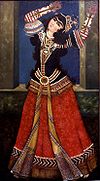
Back İranın etnik azlıqları Azerbaijani ایراندا یاشایان ائتنیکلر AZB ইরানের জাতিগোষ্ঠী Bengali/Bangla نەتەوەکانی ئێران CKB Ethnien in Iran German Etnias de Irán Spanish اقوام ساکن ایران Persian Etničke grupe Irana Croatian 이란의 민족 Korean इराणमधील वंशसमूह Marathi
| Part of a series on the |
| Culture of Iran |
|---|
 |
|
|
The majority of the population of Iran (approximately 80%) consists of Iranian peoples.[1] The largest groups in this category include Persians, mostly referred to as Fars (who form 61% of the Iranian population) and Kurds (who form 10% of the Iranian population), with other communities including Semnanis, Khorasani Kurds, Larestanis, Khorasani Balochs, Gilakis, Laks, Mazandaranis, Lurs, Tats, Talysh and Baloch.
Turkic peoples constitute a substantial minority of between 18–19%,[1] with the largest group being the Azerbaijanis. They are the second largest ethnicity in Iran. Other Turkic groups include the Turkmen, Afshar, Qashqai, Khorasani Turks, Shahsevan, Khalaj and Kazakhs peoples.
Arabs account for about 1-2% of the Iranian population. The remainder, amounting to about 1% of Iranian population, consists of a variety of minor groups, mainly comprising Iranian Iraqis, Iranian Assyrians, Iranian Jews, Iranian Armenians, Iranian Georgians, Circassians and Mandaeans.[2][3]
At the beginning of the 20th century, Iran had a total population of just below 10 million, with an approximate ethnic composition of: 4 million Persians (40%), 2.5 million Azeris (25%), 1.2 million Kurds and Baluchs each (12% each).[4]
Due to its ethnically-heterogeneous population, Iran lacks a titular ethnic group and enjoys a cultural and linguistic diversity which has been unified under a single national identity based on the standard Persian language and culture (Zana).[5]
Many of the traditional tribal groups have become urbanized and culturally assimilated during the 19th and 20th centuries, so that ethnic identity in many cases is less than clear-cut. There have also been considerable intermarriage rates between certain groups, and nearly all groups are fluent in Persian, in many cases marginalizing their traditional native tongue.[6][7][8] Some groups may identify with their status as "ethnic minority" only secondarily, or cite multiple ethnic affiliation.[9]
- ^ a b According to the CIA World Factbook, the ethnic breakdown of Iran is as follows: Persian 61%, Azeri 16%, Kurd 10%, Lur 6%, Baloch 2%, Arab 2%, Turkmen and Turkic tribes 2%, other 1%. "The World Factbook – Iran". Retrieved 21 April 2008.
- ^ Carl Waldman, Catherine Mason, Encyclopedia of European Peoples, pp.175
- ^ Russell Contrera (8 August 2009). "Saving the people, killing the faith – News – Holland Sentinel – Holland, MI". Holland Sentinel. Archived from the original on 6 March 2012. Retrieved 21 September 2015.
- ^ Ervand Abrahimian, "A History of Modern Iran", Cambridge University Press, 2008. p. 18: "Communal Composition of Iran, 1900 Persian 6 million Azeris 2.5 million Mazandaranis 200,000 Gilakis 200,000 Taleshis 20,000 Tatis 20,000"
- ^ Iran: A Modern History, Abbas Amanat
- ^ Shahrough Akhavi (1980). Religion and Politics in Contemporary Iran: Clergy-State Relations in the Pahlavi Period. State University of New York. ISBN 0-87395-456-4.
- ^ Nikki Keddie (2003). Modern Iran: Roots and Results of Revolution. Yale University Press. ISBN 0-300-09856-1.
- ^ "Socio-Economic characteristics survey of Iranian households (2002) (Amârgiri az vizhegihâ-ye ejtemâ'i eqtesadi-ye khânevâr. Tehran, Markaz-e amâr-e irân, 1382), CNRS, Université Paris III, INaLCO, EPHE, Paris, page 14" (PDF). Archived from the original (PDF) on 28 May 2008.
- ^ van Bruinessen, Martin (1978) Agha, Shaikh and State. On the Social and Political Organization of Kurdistan, University of Utrecht, Utrecht. 1978, Utrecht: footnote 102: 430
When I asked people in ethnically mixed areas whether they were Kurds of [sic] Turks or Persians I frequently got answers such as 'I am Kurd as well as a Persian and a Turk'. When I insisted and asked what they originally were, some answered 'my father speaks all three languages